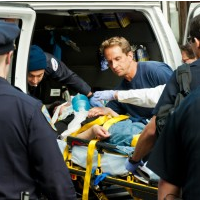S.F. Fails State 911 Response Standard―for Fourth Year in a Row
 San Francisco paramedics at work (photo: Justin Beck, Flickr)
San Francisco paramedics at work (photo: Justin Beck, Flickr)
The San Francisco Fire Department’s fleet of ambulances is old and broken down, while its crews are understaffed. As a result, it has fallen woefully short of state requirements, for four straight years, that it respond to at least 80% of the 911 medical calls it receives.
A report (pdf) this week from the Board of Supervisors Budget & Legislative Analyst chastised the department for failing to order new ambulances that had been paid for, and not deploying its personnel more effectively. The analyst made 15 recommendations and the department concurred on all but two.
One criticism that both agreed on was that it shouldn’t have taken a year for the department to put in a requisition for 10 of the 16 ambulances authorized in 2012. The San Francisco Chronicle said both Fire Chief Joanne Hayes-White and Board Supervisor London Breed, who requested the report, were almost chagrined by that, but not quite.
Hayes-White said the department took so long to place an order because officials needed time to figure out what kind of ambulances to purchase. “That's almost an embarrassment,” Breed reportedly said. “I would agree,” Hayes-White responded.
They were almost embarrassed because the new ambulances were to replace old ambulances that break down all the time. About one-third of the aged fleet is out of commission on any given day. An ambulance’s lifespan is about 10 years, and 23 of the fleet’s 43 vehicles are at least that old.
The 10 new ambulances in the pipeline are expected to arrive by the end of the year. Nine more are expected to be purchased next year.
While Hayes-White didn’t disagree with the analyst about ambulances, she did object to two of the complaints about personnel use. The chief noted employee contract restraints approved by voters that prevented her from shuffling personnel back and forth between fire response and medical response, and the nature of their goofball schedules limited the use of overtime.
The report maintains that the new city budget provides enough money for the department to hire enough new people to cover its schedule deficiencies and get to the state’s 80% response level. The chief disagrees. Hayes-White told a supervisors’ budget committee this week that the extra $3 million would pay for16 of the 42 hires she says are necessary, according to the Chronicle. She wants $10 million.
About three-fourths of the emergency calls to the Fire Department are for medical assistance; the rest are for fire suppression. The number of medical calls has risen 21.7% since 2007, compared to a 5.5% increase in fire calls.
During that time, the city’s share of emergency medical calls has fallen from 98% to 73% in 2013, after hitting a low of 69% the year before. Private companies handle calls the city can’t get to. The state lets San Francisco maintain an Exclusive Operating Area (EOA) for ambulance service as long as it provides enough support to handle 80% of the calls.
The city wants to control the service. Transporting patients to hospitals via ambulance is an important source of revenue and, according to a report earlier in the year by the analyst, “exclusive rights to the market offer significant value to the City.”
The city operated the EOA from 1981 to 2008, when the California EMS Authority rescinded it. It was re-established in 2012 after consecutive years of decline: 98% in 2007; 96% in 2008; 88% in 2009; 77% in 2010 and 72% in 2011.
–Ken Broder
To Learn More:
S.F. Lacks Medics, Ambulances to Meet 911 Needs (by Marisa Lagos, San Francisco Chronicle)
Performance Audit of Emergency Medical Services Resources at the San Francisco Fire Department (San Francisco Budget and Legislative Analyst) (pdf)
- Top Stories
- Controversies
- Where is the Money Going?
- California and the Nation
- Appointments and Resignations
- Unusual News
- Latest News
- California Forbids U.S. Immigration Agents from Pretending to be Police
- California Lawmakers Urged to Strip “Self-Dealing” Tax Board of Its Duties
- Big Oil’s Grip on California
- Santa Cruz Police See Homeland Security Betrayal in Use of Gang Roundup as Cover for Immigration Raid
- Oil Companies Face Deadline to Stop Polluting California Groundwater





